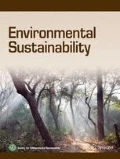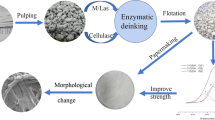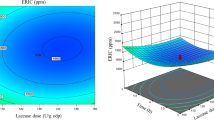Abstract
The de-inking ability of the crude laccase (benzenediol: oxygen oxidoreductase, EC 1.10.3.2) produced by a white rot fungus Peniophora sp. (NFCCI-2131) was tested using mixed office waste paper. In addition, the impact on physical and optical properties of the de-inked pulp, and the chemical load of the effluent generated during laccase based de-inking process was also analyzed. In the present study, 2.5 U/ml laccase was produced by the fungus under submerged culture conditions. Laccase (10 U/g of air dried pulp) was found to improve the tensile strength of recycled pulp by 1.7-fold, de-inking efficiency by 1.5-fold, opacity by 3.84%, and brightness by 5.83%. Scanning electron microscopy analysis revealed less rupturing of cellulose fibers and increased detachment of ink particles from the surface of the fibers in comparison to chemical de-inking. Fourier-transform infrared spectroscopy analysis of laccase treated pulp revealed degradation of the guaiacyl group and a high degree of deformation in methyl group of lignin. The biochemical and chemical oxygen demand (BOD and COD) were found to be reduced by 52 and 36% respectively, in the effluent generated after crude laccase based de-inking of mixed office waste.
Graphical abstract




Similar content being viewed by others
References
Ademakinwa AN, Agboola FK (2016) Biochemical characterization and kinetic studies on a purified yellow laccase from newly isolated Aureobasidium pullulans NAC8 obtained from soil containing decayed plant matter. Genet Eng Biotechnol J 14(1):143–151
Ai MQ, Wang FF, Zhang YZ, Huang F (2014) Purification of pyranose oxidase from the white rot fungus Irpex lacteus and its cooperation with laccase in lignin degradation. Process Biochem 49(12):2191–2198
Andreu G, Vidal T (2011) Effects of laccase-natural mediator systems on kenaf pulp. Bioresour Technol 102:5932–5937
Aracri E, Vidal T, Ragauskas AJ (2011) Wet strength development in sisal cellulose fibers by effect of a laccase—TEMPO treatment. Carbohydr Polym 84(4):1384–1390
Bajpai P (1999) Application of enzymes in the pulp and paper industry. Biotechnol Prog 15(2):147–157
Bajpai P (2012) Biodeinking. Biotechnology for pulp and paper processing. Springer, Boston, pp 139–158
Bajpai P (2014) Recycling and deinking of recovered paper. Elsevier, Amsterdam
Bansal M, Kumar D, Chauhan GS, Kaushik A (2018) Preparation, characterization and trifluralin degradation of laccase-modified cellulose nanofibers. Mater Sci Energy Technol. https://doi.org/10.1016/j.mset.2018.04.002
Bhamare HM, Jadhav HP, Sayyed RZ (2018) Statistical optimization for enhanced production of extracellular laccase from Aspergillus sp. HB_RZ4 isolated from bark scrapping. Environ Sustain. https://doi.org/10.1007/s42398-018-0015-1
Bourbonnais R, Paice MG, Freiermuth B, Bodie E, Borneman S (1997) Reactivities of various mediators and laccases with kraft pulp and lignin model compounds. Appl Environ Microbiol 63(12):4627–4632
Burgueño J, Rodriguez-couto S (2014) Enhancing laccase production by a newly- isolated strain of Pycnoporus sanguineus with high potential for enhancing laccase production by a newly-isolated potential for dye discoloration. RSC Adv 4:34096–34103
Camarero S, Garcı́a O, Vidal T, Colom J, del Rı́o JC, Gutiérrez A (2004) Efficient bleaching of non-wood high-quality paper pulp using laccase-mediator system. Enzyme Microb Technol 35(2):113–120
Chandra RP, Lehtonen LK, Ragauskas AJ (2008) Modification of high lignin content kraft pulps with laccase to improve paper strength properties. 1. Laccase treatment in the presence of gallic acid. Biotechnol Prog 20(1):255–261
Chen Y, Wan J, Ma Y, Tang B, Han W, Ragauskas AJ (2012) Modification of old corrugated container pulp with laccase and laccase—mediator system. Bioresour Technol 110:297–301
Chutani P, Sharma KK (2015) Biochemical evaluation of xylanases from various filamentous fungi and their application for the deinking of ozone treated newspaper pulp. Carbohydr Polym 127:54–63
Claus H, Faber G, König H (2002) Redox-mediated decolorization of synthetic dyes by fungal laccases. Appl Microbiol Biotechnol 59(6):672–680
CPPRI (2001a) Central Pulp and Paper Research Institute (CPPRI), Laboratory Manual of Testing Procedures. TM II-A-42
CPPRI (2001b) Central Pulp and Paper Research Institute (CPPRI), Laboratory Manual of Testing Procedures. TM II-B2
Desai DI, Iyer BD (2016) Biodeinking of old newspaper pulp using a cellulase-free xylanase preparation of Aspergillus niger DX-23. Biocatal Agric Biotechnol 5:78–85
Eugenio ME, Santos SM, Carbajo JM, Martín JA, Martín-sampedro R, González AE (2010) Kraft pulp biobleaching using an extracellular enzymatic fluid produced by Pycnoporus sanguineus. Bioresour Technol 101:1866–1870
Fillat U, Roncero MB (2010) Optimization of laccase—mediator system in producing biobleached flax pulp. Bioresour Technol 101:181–187
Gupta V, Garg S, Capalash N, Gupta N, Sharma P (2015) Production of thermo-alkali-stable laccase and xylanase by co-culturing of Bacillus sp. and Bacillus halodurans for biobleaching of kraft pulp and deinking of waste paper. Bioprocess Biosyst Eng 38(5):947–956
Heinze T, Liebert T (2001) Unconventional methods in cellulose functionalization. Prog Polym Sci 26(9):1689–1762
Ibarra D, Monte MC, Blanco A, Martínez AT, Martínez MJ (2012) Enzymatic deinking of secondary fibers: cellulases/hemicellulases versus laccase-mediator system. J Ind Microbiol Biotechnol 39(1):1–9
Jahangiri E, Thomas I, Schulze A, Seiwert B, Cabana H, Schlosser D (2018) Characterisation of electron beam irradiation-immobilised laccase for application in wastewater treatment. Sci Total Environ 15:309–322
Jeffries TW, Viikari L (1996) Enzymes for pulp and paper processing. American Chemical Society, Washington, DC, p 326 (ACS symposium series)
Justino CI, Duarte K, Loureiro F, Pereira R, Antunes SC, Marques SM (2009) Toxicity and organic content characterization of olive oil mill wastewater undergoing a sequential treatment with fungi and photo-Fenton oxidation. J Hazard Mater 172(2):1560–1572
Khalil HPSA, Hossain MS, Rosamah E, Norulaini NAN, Leh CP, Asniza M (2014) High-pressure enzymatic hydrolysis to reveal physicochemical and thermal properties of bamboo fiber using a supercritical water fermenter. BioResources 9(4):7710–7720
Kiiskinen LL, Palonen H, Linder M, Viikari L, Kruus M (2004) Laccase from Melanocarpus albomyces binds effectively to cellulose. FEBS Lett 576(1):251–255
Kuhad RC, Mehta G, Gupta R, Sharma KK (2010) Fed batch enzymatic saccharification of newspaper cellulosics improves the sugar content in the hydrolysates and eventually the ethanol fermentation by Saccharomyces cerevisiae. Biomass Bioenergy 34(8):1189–1194
Kumar A, Dutt D, Gautam A (2016) Production of crude enzyme from Aspergillus nidulans AKB-25 using black gram residue as the substrate and its industrial applications. Genet Eng Biotechnol J 14(1):107–118
Kumar NV, Rani ME, Gunaseeli R, Kannan ND (2018) Paper pulp modification and deinking efficiency of cellulase–xylanase complex from Escherichia coli SD5. Int J Biol Macromol 111:289–295
Lee CK (2011) Enzymatic and chemical deinking of mixed office wastepaper and old newspaper: paper quality and effluent characteristics. BioResources 6(4):3859–3875
Lee CK, Ibrahim DI, Omar C (2013) Enzymatic deinking of various types of waste paper: efficiency and characteristics. Process Biochem 48(2):299–305
Liu M, Yang S, Long L, Wu S, Sing S (2017) The enzymatic de-inking of waste papers by engineered bifunctional chimeric neutral lipase–endoglucanase. BioResources 12(3):6812–6831
Miller GL (1959) Use of dinitrosalicylic acid reagent for determination of reducing sugar. Anal Chem 31(3):426–428
Mohandass C, Knutson K, Ragauskas AJ (2008) Laccase treatment of recycled blue dyed paper: physical properties and fiber charge. J Ind Microbiol Biotechnol 35(10):1103–1108
Naraian R, Kumari S, Gautam RL (2018) Biodecolorization of brilliant green carpet industry dye using three distinct Pleurotus spp. Environ Sustain. https://doi.org/10.1007/s42398-018-0012-4
Nishiyama Y, Sugiyama J, Chanzy H, Langan P (2003) Crystal structure and hydrogen bonding system in cellulose I(alpha) from synchrotron X-ray and neutron fiber diffraction. J Am Chem Soc 125(47):14300–14306
Pala H, Mota M, Gama FM (2004) Enzymatic versus chemical deinking of non-impact ink printed paper. J Biotechnol 108(1):79–89
Park S, Baker JO, Himmel ME, Parilla PA, Johnson DK (2010) Cellulose crystallinity index: measurement techniques and their impact on interpreting cellulase performance. Biotechnol Biofuels 24(3):10–20
Parker FS (1971) Applications of infrared spectroscopy in biochemistry, biology, and medicine. Springer, Boston
Pathak P, Bhardwaj NK, Singh AK (2014a) Production of crude cellulose and xylanase from Trichoderma harzianum (PPDDN) 10, (NFCCI)-2925 and its application in photocopier waste paper recycling. Biotechnol Appl Biochem 172(8):3776–3797
Pathak P, Bhardwaj NK, Singh AK (2014b) Production of crude cellulase and xylanase from Trichoderma harzianum PPDDN10 NFCCI-2925 and its application in photocopier waste paper recycling. Appl Biochem Biotechnol 172(8):3776–3797
Ravalason H, Bertaud F, Herpoël-gimbert I, Meyer V, Ruel K, Joseleau J (2012) Laccase/HBT and laccase-CBM/HBT treatment of softwood kraft pulp: impact on pulp bleachability and physical properties. Bioresour Technol 121:68–75
Rice EW (2012) Standard methods for the examination of water and wastewater, 22nd edn. American Public Health Association, Washington, DC, p 1120
Rich JO, Anderson AM, Berhow MA (2016) Laccase-mediator catalyzed conversion of model lignin compounds. Biocatal Agric Biotechnol 5:111–115
Rodriguez-couto S (2014) Decolorization of the metal textile dye Lanaset Grey G by immobilized white-rot fungi. J Environ Manage 129:324–332
Saxena A, Singh Chauhan P (2017) Role of various enzymes for deinking paper: a review. Crit Rev Biotechnol 37:598–612
Shankar S, Shikha (2012) Laccase production and enzymatic modification of lignin by a novel Peniophora sp. Appl Biochem Biotechnol 166(4):1082–1094
Shankar S, Shikha (2015) Effects of metal ions and redox mediators on decolorization of synthetic dyes by crude laccase from a novel white rot fungus Peniophora sp. (NFCCI-2131). Appl Biochem Biotechnol 175(1):648
Sharma A, Thakur VV, Shrivastava A, Jain RK, Mathur RM, Gupta R (2014) Xylanase and laccase based enzymatic kraft pulp bleaching reduces adsorbable organic halogen (AOX) in bleach effluents: a pilot scale study. Bioresour Technol 169:96–102
Singh A, Yadav RD, Kaur A, Mahajan R (2012) An ecofriendly cost effective enzymatic methodology for deinking of school waste paper. Bioresour Technol 120:322–327
TAPPI (1996) TAPPI test methods. TAPPI Press, Atlanta
Thakur VV, Jain RK, Mathur RM (2012) Studies on xylanase and laccase enzymatic prebleaching to reduce chlorine-based chemicals during CEH and ECF bleaching. BioResources 7(2):2220–2235
Valls C, Roncero MB (2009) Using both xylanase and laccase enzymes for pulp bleaching. Bioresour Technol 100(6):2032–2039
Verma N, Bansal M, Kumar V (2011) Enzymatic deinking with cellulases: a review. J Solid Waste Technol Manage 37(4):297–306
Virk AP, Puri M, Gupta V, Capalash N, Sharma P (2013) Combined enzymatic and physical deinking methodology for efficient eco-friendly recycling of old newsprint. PLoS One 8(8):723–746 (Agarwal PK, editor)
Vyas S, Lachke A (2003) Biodeinking of mixed office waste paper by alkaline active cellulases from alkalo tolerant Fusarium sp. Enzyme Microb Technol 32(2):236–245
Xu QH, Wang YP, Qin MH, Fu YJ, Li ZQ, Zhang FS (2011) Fiber surface characterization of old newsprint pulp deinked by combining hemicellulase with laccase-mediator system. Bioresour Technol 102(11):6536–6540
Zhang X, Renaud S, Paice M (2008) Cellulase deinking of fresh and aged recycled newsprint/magazines (ONP/OMG). Enzyme Microb Technol 43(2):103–108
Acknowledgements
Young Scientist Fellowship (Award no: CST/242/, dated 12/05/2015, Council of Science and Technology Uttar Pradesh, Lucknow India) to first author Dr. Shiv Shankar is gratefully acknowledged. The authors acknowledge Dr. R. K. Jain, Director, Central Pulp, and Paper Research Institute Saharanpur, India and Ms. Prachi Kaushik, Senior Research Fellow, CPPRI, Saharanpur for their help in the analysis of physical and optical properties of the paper. The authors are thankful to Vice Chancellor, Babasaheb Bhimrao Ambedkar University, and Head, Department of Environmental Science, Babasaheb Bhimrao Ambedkar University (A Central University) for rendering necessary facilities.
Author information
Authors and Affiliations
Corresponding author
Rights and permissions
About this article
Cite this article
Shankar, S., Shikha, Bhan, C. et al. Laccase based de-inking of mixed office waste and evaluation of its impact on physico-optical properties of recycled fiber. Environmental Sustainability 1, 233–244 (2018). https://doi.org/10.1007/s42398-018-0021-3
Received:
Revised:
Accepted:
Published:
Issue Date:
DOI: https://doi.org/10.1007/s42398-018-0021-3




